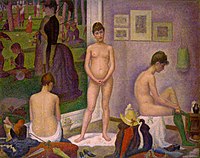Modern art
Modern art refers to artistic works produced from the 1860s to about the 1970s. It refers to the style and philosophy of the art produced during that era.[1]p102 The period coincides with the invention of mechanical means of recording images: photography and film.[2]





The term modern art is usually associated with art in which the traditions of the past have been thrown aside in a spirit of experimentation.[3]p419 Modern artists experimented with new ways of seeing and with fresh ideas about the nature of materials and functions of art. A tendency toward abstraction is characteristic of much modern art, including minimalism . More recent artistic production is often called Contemporary art or Postmodern art.
History
changeModern art begins with the heritage of painters like Vincent van Gogh, Paul Cézanne, Paul Gauguin, Georges Seurat and Henri de Toulouse-Lautrec all of whom were essential for the development of modern art. At the beginning of the 20th century Henri Matisse and several other young artists including the pre-cubist Georges Braque, André Derain, Raoul Dufy and Maurice de Vlaminck revolutionized the Paris art world with 'wild', multi-colored, expressive, landscapes and figure paintings that the critics called Fauvism.
Henri Matisse's two versions of The Dance marked a key point in his career and in the development of modern painting.[4] It reflected Matisse's fascination with primitive art: the intense warm color of the figures against the cool blue-green background and the rhythmical succession of the dancing nudes convey the feelings of emotional liberation and hedonism.
Pablo Picasso made his first cubist paintings based on Cézanne's idea that all depiction of nature can be reduced to three solids: cube, sphere and cone. With the painting Les Demoiselles d'Avignon 1907, Picasso dramatically created a new and radical picture depicting a raw and primitive brothel scene with five prostitutes, violently painted women, reminiscent of African tribal masks and his own new Cubist inventions.
Analytic cubism was jointly developed by Pablo Picasso and Georges Braque, exemplified by Violin and Candlestick, Paris, from about 1908 through 1912. Analytic cubism, the first clear manifestation of cubism, was followed by Synthetic cubism, practised by Braque, Picasso, Fernand Léger, Juan Gris, Albert Gleizes, Marcel Duchamp and several other artists into the 1920s. Synthetic cubism is characterized by the introduction of different textures, surfaces, collage elements, papier collé and a large variety of merged subject matter.
The notion of modern art is closely related to Modernism.
- "One way of understanding the relation of the terms 'modern,' 'modernity,' and 'modernism' is that... modernist art is scarcely thinkable outside the context of the modernized society of the late nineteenth and twentieth centuries. Social modernity is the home of modernist art, even where that art rebels against it".[5]p13
Modern art was introduced to the United States in 1913 and through European artists who moved to the U.S. during World War I. It was only after World War II, however, that the U.S. became the focal point of new artistic movements. The 1950s and 1960s saw the emergence of Abstract Expressionism, one of the most important of the later modernist art movements.
Auction prices
changeModern art and Impressionism dominate the world art markets. Of the 20 top art prices, only one is a work of classical art. The world's highest price for a work of art is Jackson Pollock's No. 5, 1948 privately sold by Sotheby's for (price adjusted) $151.2 million dollars. The modern paintings overtook the old masters in 1987.
References
change- ↑ Atkins, Robert. 1990. Artspeak: a guide to contemporary ideas, movements, and buzzwords. New York: Abbeville Press. ISBN 1-55859-127-3
- ↑ Scharf, Aaron 1974. Art and photography. Penguin, Harmondsworth. ISBN 0-14-021722-3
- ↑ Gombrich E.H. 1958. The Story of Art. London: Phaidon.
- ↑ Russell T. Clement. Four French Symbolists. Greenwood Press, 1996. Page 114.
- ↑ Cahoone, Lawrence E. 1996. From Modernism to Postmodernism: an anthology. Blackwell, Oxford. ISBN 1-55786-603-1